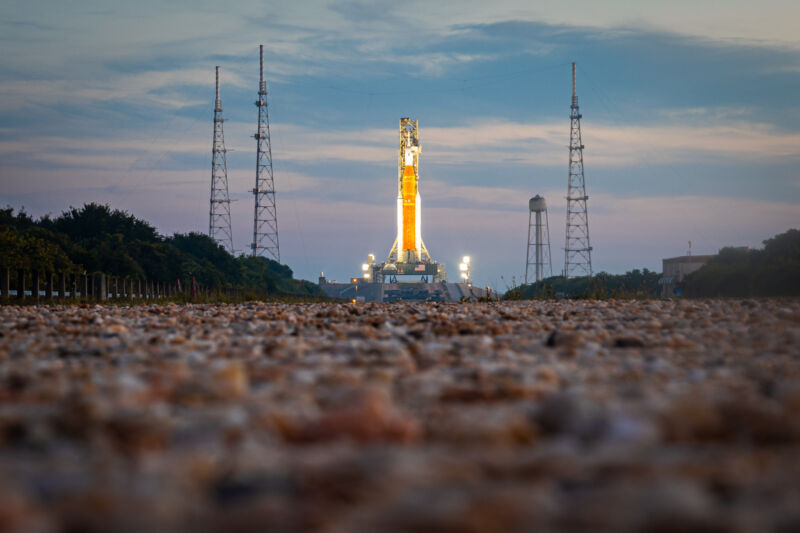
KENNEDY SPACE CENTER, Fla.—Despite all of the hard work by its engineers and technicians, NASA did not really get close to firing up the massive Space Launch System (SLS) rocket on Monday.
The rocket experienced several issues during the countdown early on Monday before running into a technical problem the launch team could not solve: an RS-25 rocket engine that did not properly chill down prior to ignition. Even if the engine problem had been resolved, weather along the Florida coast on Monday morning proved dicier than anticipated.
Space is hard, certainly. But Monday's attempt—which NASA had promoted heavily by inviting celebrities to the launch and which included a visit by Vice President Kamala Harris—was perhaps a bit rushed. Why? Because NASA rolled a rocket out to launch without accounting for all of the things that could go wrong.
To their credit, the launch controllers successfully worked through a host of issues on Monday prior to the scrub. For example, fueling operations started nearly two hours late due to lightning in proximity to the launch pad. This forced the team to push hard through a compressed timeline ahead of a launch window that opened at 8:33 am ET (12:33 UTC).
Once the launch team got into propellant loading, work to fill the large liquid hydrogen tank was stymied by a leak at an 8-inch inlet leading into the tank. This problem was ultimately resolved by stopping the process and then restarting propellant loading—yes, NASA resolved the problem by essentially turning off the SLS and turning it back on again.
After this, the countdown proceeded reasonably smoothly for about an hour until a problem with one of the rocket's four main engines. As part of the pre-launch process, cryogenic propellant is "bled" from the fuel tanks into the engines to chill them to about 5° Celsius prior to flight. (In responding to a question about the engine temperature, Artemis I Mission Manager Mike Sarafin actually gave the temperature as "500 Rankine.")
In troubleshooting this engine issue, launch controllers could not find a way to address what appears to have been a problem on the core stage side of the vehicle. So the launch attempt was scrubbed.
"I am very proud of this launch team," NASA Administrator Bill Nelson said during a briefing after the scrub.
And well he should be, given the hard work done late Sunday night and Monday morning during the final portions of the countdown. But should the flight controllers have been put in such a position?
Beginning in April of this year, NASA conducted four separate "wet dress rehearsal" tests during which the agency aimed to fully fuel the SLS rocket and countdown to T-10 seconds, ending the test before ignition of the main engines. Each of these four tests ultimately ended prematurely, although the fourth attempt in June saw engineers bring the rocket down to T-29 seconds.
However, to reach that late stage in the countdown, NASA had to "fool" the flight computer. During the test, a 4-inch hydrogen line—smaller than the problematic 8-inch line on Monday—had a leaky seal. To complete the wet dress test, NASA chose to mask the leak from the ground launch sequencer, the ground-side computer that controls the majority of the countdown.
Because of this masking, NASA could not complete the engine chill portion of the test. Had it done so, the agency may well have uncovered the problem that caused a scrub on Monday. In hindsight, therefore, NASA probably should have completed a full wet dress rehearsal before rolling the rocket out for a launch. Instead, the agency effectively attempted a fifth wet dress test on Monday, when the world was expecting a launch.
NASA's chief of human exploration systems development, Jim Free, defended the decision to attempt a launch on Monday without completing a wet dress test. "We felt, and still feel, like going for today was the right thing to do," Free said of the launch attempt.
Free said NASA is conscious of the wear-and-tear involved in rolling the SLS rocket to and from the launch pad for additional wet-dress tests and in pressurizing the tanks during fueling. Those risks must be balanced against challenges during the countdown.
Now, NASA may be rolling the rocket back to the Vehicle Assembly Building at Kennedy Space Center anyway. Agency officials said they were leaving open the possibility of a launch attempt at 12:48 pm ET on Friday, September 2. After a meeting on Tuesday afternoon to discuss possible fixes to the engine bleed issue, mission managers will announce a plan forward.
If the rocket cannot launch by September 5, it will need to go back to the hangar for additional work. Then, it's likely that the rocket would not launch before mid-October.
reader comments
692